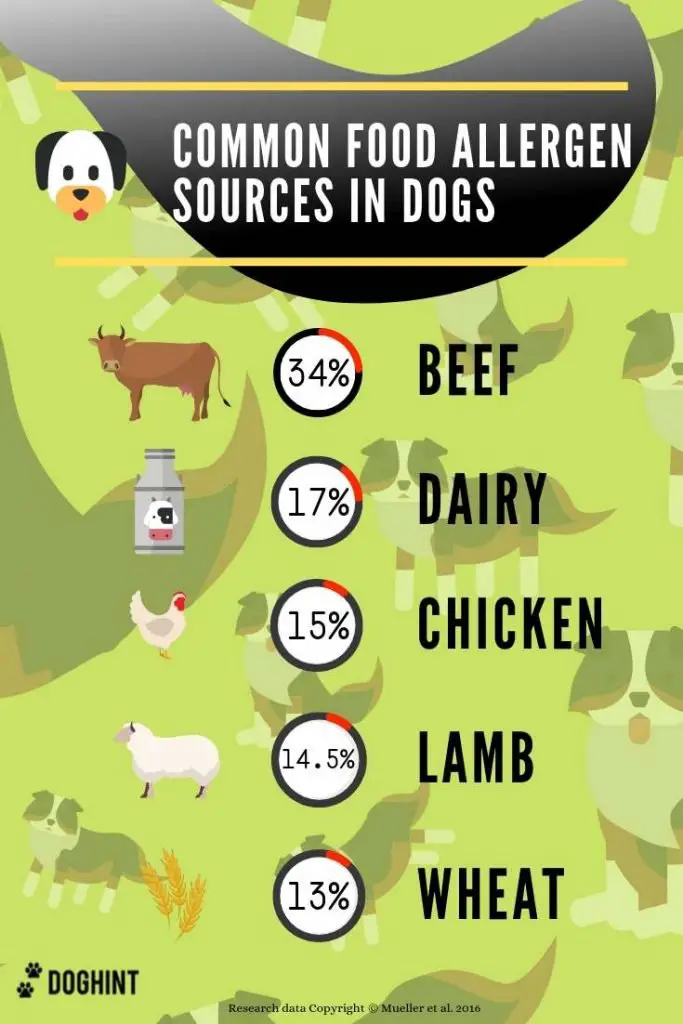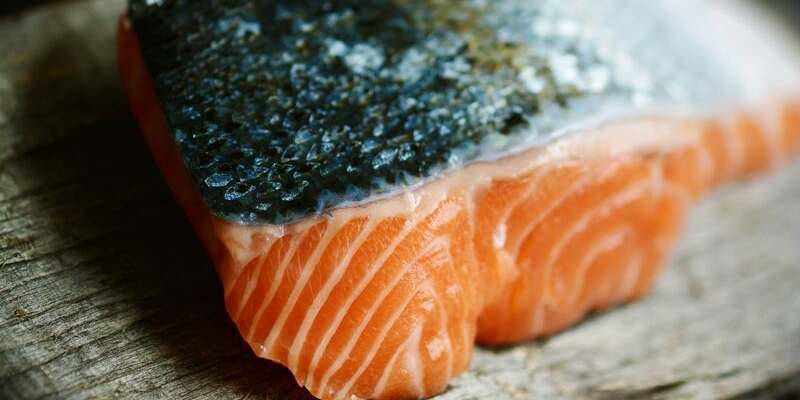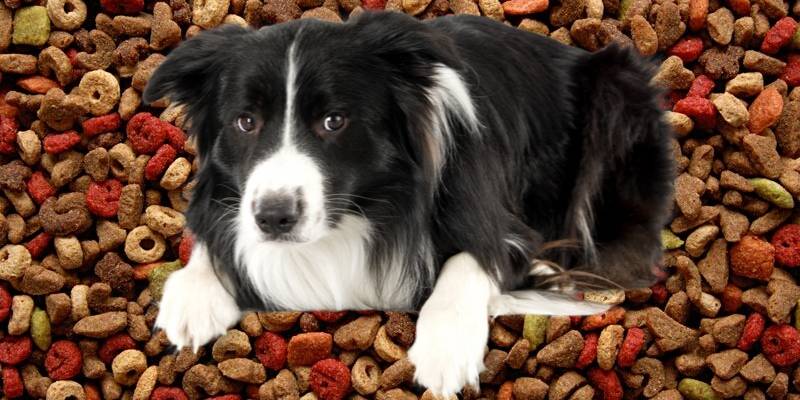First of all, thank you so much for clicking through and being on this page! I’ll do my best to deliver all the content you might expect to find and answer all the possible related questions.
Your time is super important, so let me quickly explain what is covered in this guide and how to navigate it.
If you are here just to find out what’s the best hypoallergenic dog food, then Doghint’s best suggestion would be Salmon recipe from Nylo. It’s patented probiotics blend included in the formula helps your pup with controlling allergy symptoms and better digestion. And the formula pretty much rules out all most common allergens – from wheat, soy, and eggs to potato and tapioca.
Otherwise, keep reading:
In the research below, I’ll cover everything from most common canine allergens to how to treat adverse food reactions in pups. And also uncover the best commercial and homemade recipes to ensure that all the nasty symptoms are gone.
You can use the table of contents below to jump to the most appealing section quickly. And you can go back to the beginning of the article by clicking on the black arrow on the bottom right corner of the page.
I put 40 hours of research while working on this piece, so I really hope it will be helpful.
- Types of Allergies in Dogs
- Dog allergies VS food intolerance
- Dog allergy to food symptoms
- Dog allergies food list
- Food allergy testing for dogs
- What is hypoallergenic dog food?
- Hypoallergenic dog food brands and options
- Best dog food for allergies
- Hypoallergenic homemade dog food
- How to make hypoallergenic dog treats?
Types of Allergies in Dogs
Allergies are the reactions to nonnative substances by the immune system. There are several types of allergies in canines, according to the American Kennel Club (AKC). Skin allergies, environmental allergens, and, of course, food allergies. Any of those are not the most pleasant condition to suffer from. And even though the symptoms of all three kinds of allergies can overlap, from now on, we will be focusing mainly on food-related issues.

Dog allergies VS food intolerance

Food allergies may not be as prevalent as people believe, according to AKC Chief Veterinary Officer Dr. Jerry Klein. The real allergy results in an immune response, which, in some cases, may end with anaphylaxis — similar to peanut allergies in humans.
So in most cases, when we say: “My pup is allergic to X,” what we are really dealing with is a food intolerance, also referred to as a food sensitivity. Those do not involve an immune response. It’s just a progressive reaction to a specific ingredient in your dog’s food, for example to beef, milk or wheat.
Dogs with food sensitivities can suffer from various outcomes, including gastrointestinal symptoms such as vomiting and diarrhea, or dermatologic signs like itchiness, bad skin and coat, and chronic ear or foot infections.
According to the research by the Canadian Veterinary Medical Association published in March 2019 in 60% cases, “food allergy” was diagnosed by dog owners. And that alone poses some doubts on the accuracy of the claim.
However, whether it’s a real life-threatening immune response or just a food sensitivity, your pup shouldn’t be suffering from any.

Dog allergy to food symptoms
Food allergies are one kind of adverse food reaction (AFR) that happens in dogs. As I’ve mentioned earlier, those reactions can be classified as either non-immune-mediated food reactions (e.g., lactose intolerance) or immune-mediated food reactions. However, it’s challenging to identify one from another. According to the researches, a median prevalence of 6% of all skin diseases in dogs and 20% of all allergic, dermatological signs in dogs, have been attributed to food reactions.
Of the regularly reported gastrointestinal signs in dogs, 10% to 15% are attributed to AFRs, including unpredictable bowel movements, excessive gas, and nausea.

Dog allergies food list
Some research was done in an attempt to identify the most common dog food allergen.
The most thorough job was done by Ralf S. Mueller from Centre for Clinical Veterinary Medicine, Ludwig Maximilian University, Munich, Germany, and Thierry Olivry from Department of Clinical Sciences, College of Veterinary Medicine, North Carolina State University, Raleigh, NC USA.
They searched for, reviewed, and analyzed two massive databases: The CAB Abstracts and Web of Science. They used the following string: ((dog or dogs or canine) or (cat or cats or feline)) and (food or diet*) and (allerg* or atop* or hypersens* or intolerance). The search was limited to the period 1985 to 2015.
Going through all the data, they were trying to establish the most likely food allergens contributing to canine adverse food reactions. And, as it turned out, those were beef (34% of all reports), dairy products (17%), chicken (15%), lamb (14.5%), and wheat (13%).
Other less regularly reported food sources were soy (18 dogs, 6 %), corn (13 dogs, 4 %), egg (11 dogs, 4 %), pork (7 dogs, 2 %), fish and rice (5 dogs each, 2 %). Barley, rabbit, kidney beans, chocolate, and tomato were also reported as food allergens for single dogs. Although, as most pet parents aware that chocolate is a no for dogs, it’s not likely that many of all reported dogs were eating it.


Food allergy testing for dogs
As pointed out Brennen McKenzie, MSc, VMD, in his article for Veterinary Practice News, the only reliable way to spot particular foods triggering allergic effects in a patient are hydrolyzed protein or novel-protein diet trials. Those have to last from four weeks to four months, and they expect strict pet parent compliance and accurate reporting of symptoms.
After that, challenge trials with specific foods should be conducted. Those will help to identify the likely reason for any intolerances. This gold-standard testing framework is not always plausible. But unfortunately, none of the alternatives (including commercial skin and blood allergy tests) have confirmed to be as reliable. Even though they might be very costly and time-consuming.
Any food intolerance can continue during a lifetime. The primary purpose of managing allergies or adverse food reactions is to spot and avoid the food responsible for all the troubling signs. And that’s when hypoallergenic food might become handy.


What is hypoallergenic dog food?
Hypoallergenic dog food diets are based on a variety of unique protein sources. Which are not yet recognized by the dog’s antibodies as being antigens, reducing allergic reactions.
Those diets may be based on so-called “novel” proteins, entirely new for the dog. Also, the menu should have a unique source of carbs since plants also include protein.
Hypoallergenic dog food options might be venison and potato, salmon and pea or even kangaroo, as long as the dog hasn’t been eating those ingredients in the past. Lamb also used to be included in the hypoallergenic list, but as so many commercial diets include it nowadays, it ‘s not that novel anymore. And, as research mentioned before uncovered, it can be quite a common allergen.
Hydrolyzed protein-based diets are made when animal proteins are broken down into tiny particles. So small that the immune system won’t be able to recognize it as allergens, practically diminishing the possibility of an adverse food reaction. Starch or rice are most commonly used as carbs sources because they are very rarely linked to pets allergic reactions.
Few more tips: watch out for additives. Chemicals, preservatives, colorants, and flavorings in most cases won’t cause an allergy but can provoke an adverse food reaction symptoms.
Also, you have to remember that certain nutrients must be incorporated into a hypoallergenic diet to help ease the symptoms of an allergic response. Those might include Vitamins A and E, omega-3 fatty acids, zinc, and more.


Hypoallergenic dog food brands and options
Royal Canin hypoallergenic dog food
This dry food made with hydrolyzed protein. And it’s great to start your allergen-seeking journey. This diet is moderate in calories, so it’s easy to maintain your pet’s healthy weight. The formula also includes omega-3 fatty acids, B-vitamins, and balanced amino acids to promote your dog’s skin strength. Along with digestive support complex of fructooligosaccharides, zeolite, and beet pulp to stabilize stools and boost overall intestinal health in dogs. Not too shabby, if you ask me.
You can check the current price and more reviews about this product on its Amazon page .
Purina hypoallergenic dog food
This formula by Purina also features a single hydrolyzed protein. It minimizes existing allergic reactions in your pet and rules out the possible allergens during future testing. Suited not only for dogs that have food-related dermatitis, gastroenteritis. It also works well for pups suffering from inflammatory bowel disease, or pancreatitis. And on top of the benefits’ list – this stuff is less expensive and easier to store than some alternatives.
You can check the current price and more reviews about this product on its Amazon page .
Acana hypoallergenic dog food
Made with a single, easily digestible animal protein (in this case “novel” protein – grass-fed lamb), these treats from Acana are a delicious reward that dogs crave. Freeze-dried, limited-ingredient, and biologically appropriate – the treats seem like a gift. It’s bad enough to have adverse food reactions, but it’s even worse to struggle and be deprived of anything delicious. That’s a solution. A little pricier than other treats but they are good ingredients, and you can break them into smaller pieces to make it last if you’d like.
You can check the current price and more reviews about this product on its Amazon page .
Iams hypoallergenic dog food
This option from Iams is not 100% hypoallergenic per se. However, if you know that your pupper is fine with chicken (Farm-raised chicken – recipe’s main protein) but sensitive to grains, that can be a product worth trying. A tailored blend of wholesome fiber and natural prebiotics aids healthy digestion, and omega-6 and -3 support your dog’s skin and shiny coat.
Ingredient-wise it is excellent and a decent grain-free choice. And I’d strongly suggest to give it a better look if your pup suffers from skin issues. As numerous pet owners reported that this particular food helped them to get rid of skin problems for good.
You can check the current price and more reviews about this product on its Amazon page .
Nulo hypoallergenic dog food
This allergy-sensitive formula by Nulo features single protein (salmon or turkey – whatever your pet is not allergic to). And rules out pretty much all most common allergens – from wheat, soy, and eggs to potato and tapioca. Patented probiotics blend included in the formula helps your pup with controlling allergy symptoms and better digestion. So good, that some pet owners refer to it as “the best thing to ever happen to my dog.”
You can check the current price and more reviews about this product on its Amazon page .

Best dog food for allergies
Grain-free hypoallergenic dog food
Zignature limited ingredient grain-free turkey dog food formula
Facts and numbers: protein – 31%, fat – 18%, fiber – 6%, calories – 457 kcal/cup
Main ingredients: Turkey, Turkey Meal, Chickpeas, Blueberries, Carrots, Cranberries, Peas, Pea Protein, Sunflower Oil (preserved with Citric Acid), Flaxseed + more nutrients and vitamins. Doesn’t contain taurine.
Zignature is our choice in this category due to the high quality of ingredients. They are trying to rule out all the common troublesome ingredients like chicken, corn, wheat, soy, and potatoes, creating peak hypoallergenic, low-glycemic nutrition.
Though it is not the cheapest dog food on the market. But it is a very high-quality option with minimal fillers, and you’ll feel good about feeding it to your pupper. And numerous dog parents reported that any previously spotted food adverse reactions (from itching to smelly ears) were gone after switching to Zignature.
You can check the current price and more reviews about this product on its Amazon page . And they also sell it at Chewy.com. For Chewy’s customers’ reviews, click here.
Hypoallergenic wet dog food
Facts and numbers: protein – 7%, fat – 5%, fiber – 1,5%, calories – 467 kcal/can
Main ingredients: Water, Salmon, Rice, Fish, Potato Protein, Corn Oil, Carrots, Inulin, Vitamin E Supplement, Folic Acid, Vitamin D-3 Supplement, Biotin + more nutrients and vitamins.
The consistency of this food is pretty moist, not watery but quite soft. But most of the pups don’t mind and seems to like the recipe. It’s quite easy to digest and comes with lots of nutrients and supplements. The main protein is salmon.
It’s loaded with DHA – an omega fatty acid that promotes cognitive development and skin health. And, again, helps to rule out the allergens that affect your dog’s health. The product comes in packs of 12, which makes it a pretty good deal.
You can check the current price and more reviews about this product on its Amazon page . And they also sell it at Chewy.com. For Chewy’s customers’ reviews, click here.
Cheap hypoallergenic dog food
Facts and numbers: protein – 21%, fat – 12%, fiber – 4%, calories – 392 kcal/cup
Main ingredients: Chicken, Brewers Rice, Chicken Meal, Yellow Peas, Cracked Pearled Barley, Whole Grain Sorghum, Egg Product, Chicken Fat, Soybean Oil, Brown Rice, Dried Beet Pulp, Chicken Liver Flavor, Lactic Acid, Pork Liver Flavor, Riboflavin Supplement, Biotin, Vitamin B12 Supplement, Vitamin E + more vitamins and minerals.
This chicken recipe by Hill’s tends to be working pretty well for curing allergies, as reported by many pet parents. This food can keep pup’s allergies under control for most of the year.
Created for adult dogs with sensitive stomachs, the formula fortified with the whole range of antioxidants and vitamins to help support a healthy immune system. And purchasing the product in bulk (the largest packaging of 30lb) is a real steal.
You can check the current price and more reviews about this product on its Amazon page . And they also sell it at Chewy.com. For Chewy’s customers’ reviews, click here.
Affordable hypoallergenic dog food
Facts and numbers: protein – 34%, fat – 17%, fiber – 3.5%, calories – 436 kcal/cup
Main ingredients: Deboned Lamb, Chicken Meal, Chickpeas, Split Peas, Pork Meal, Chicken Fat (preserved with Mixed Tocopherols), Dried Potatoes, Lamb Meal, Venison Meal, Biotin, Vitamin E Supplement + more nutrients and vitamins.
Even though this product by Crave is high protein (34%) made of very high-quality ingredients, including two novelty proteins – pasture-fed Lamb and Venison. It contains no soy, corn or wheat, no artificial preservatives or flavors, any of that. It also has very nice packaging which should keep it fresh for some time.
It’s not labeled as hypoallergenic food. However, many pet owners reported their pets’ recovery from various adverse food reactions when switching to this recipe. So I’d give it a closer look if you are considering all possible affordable options.
And you get a great quite a fantastic price, considering the quality when purchasing 22lb pack, especially when signing up for a subscription.
You can check the current price and more reviews about this product on its Amazon page . And they also sell it at Chewy.com. For Chewy’s customers’ reviews, click here.
Hypoallergenic dry dog food
Facts and numbers: protein – 30%, fat – 18%, fiber – 5.5%, calories – 438kcal/cup
Main ingredients: Deboned Salmon, Salmon Meal, Chickpeas, Chickpea Flour, Canola Oil (preserved with Mixed Tocopherols & Citric Acid), Sweet Potatoes, Miscanthus Grass, Vitamin B12 Supplement, Vitamin D3 Supplement, Folic Acid + more vitamins and nutrients.
Limited ingredient diet is very efficient for pups with food sensitivities. And on top of it, Nulo’s recipe contains a bunch of vitamins, antioxidants and a patented probiotic (patent #7,713,726, February 13, 2007) – the first of its kind – to improving your pup’s gut and digestive health. This is high protein (30%) formula, featuring salmon. Good… No… Excellent dog food to try if your pupper is struggling with any adverse food reactions.
You can check the current price and more reviews about this product on its Amazon page . And they also sell it at Chewy.com. For Chewy’s customers’ reviews, click here.
Best dog food for skin allergies
Facts and numbers: protein – 25%, fat – 14%, fiber – 4,5%, calories – 337kcal/cup
Main ingredients: Salmon, Fish Meal, Potatoes, Lentils, Peas, Pea Flour, Fava Beans, Canola Oil, Dried Yeast, Flaxseed, Tomato Pomace, Natural Flavor, Dicalcium Phosphate, Salt, DL-Methionine, Choline Chloride, Taurine, Dried Chicory Root, Kale, Chia Seed, Pumpkin, Blueberries, Oranges, Dried Kelp, Coconut, Spinach, Carrots + probiotics, minerals and nutrients.
Made with ingredients of terrific quality, Diamond Naturals ensures that every pup gets complete, holistic nutrition. If your dog is always itching, even on a grain-free diet, this recipe is worth your consideration. Its main protein is salmon that makes dog’s coat look silks and soft.
It’s not as smelly as you might expect, but dogs reportedly enjoy it quite a bit. Plus, it’s loaded with probiotics for optimal nutrition and digestive support for dogs of all sizes and ages.
You can check the current price and more reviews about this product on its Amazon page . And they also sell it at Chewy.com. For Chewy’s customers’ reviews, click here.

Hypoallergenic homemade dog food

There are many outstanding hypoallergenic dog food recipes on the market. But if you have no trust in it, you can always try to make a homemade meal for your pup.
Although you have to remember that making good dog food that includes all the necessary nutrients is not as straightforward as it may appear. It also may be more costly than purchasing a hypoallergenic diet. Here are some tips in case you are willing to homemade prep meals for your pup with food sensitivities and allergies.
- It is essential to add optimal supplements and vitamins when cooking homemade food for your pup. Even many creators of dog food recipes sometimes lacking knowledge about that ideal nutritional balance your pup needs. This results in pup’s decreased energy, weight loss, and other health issues.
- To make sure that a homemade food recipe is wholesome, always pick a recipe that has been overseen by veterinarian or canine nutritionist.
- Most dog parents know that certain human foods can be unsafe for dogs (e .g. onions, garlic, grapes, chocolate, etc.) Unfortunately, not all authors of homemade dog food recipes are as informed on the subject. Therefore the recipe might end up including a bunch of questionable ingredients.
- Don’t experiment when making meals for your pet. It’s better not to improvise and follow the recipe. For example, the directions say that you need to use boned chicken with the skin. But if you use the fillet instead, you’ll change the nutrition value of the recipe. So, your pup won’t get all the vitamins he or she needs.
- Using a food is a must. It’s the most secure way to guarantee that you use the correct amount of ingredients for that perfect nutritional balance of each meal.
- Cook all of the components of the meal. Therefore you’ll eliminate all the nasty bacteria and microorganisms that might get your pup sick.
With that being said: here’s a recipe from The Dog Bakery who’s human-grade are a big hit amongst pup parents, so they know what they are doing.

You will need:
- 2 tablespoons olive oil
- 1 squash
- 3 potatoes (any kind)
- 2 carrots
- 1 head of broccoli (with stem)
- 2 salmon portions SKIN ON (check our article about giving salmon skin to your pup) (1 oz per 10 pounds of pup’s weight)
Here’s how you make the meal:
- Chop broccoli stem, cut the squash and peel the carrots. Mix all veggies together and steam it.
- Bake potato shavings.
- Pan fry salmon (skin on) in 1 tablespoon olive oil.
- Once everything is finished cooking mix it all in a pup’s bowl, but let it cool for 15-20 mins before serving (too hot!!)

How to make hypoallergenic dog treats?
As for the treat, I found a recipe that seems dog-safe, both allergy- and other risks wise.
The main ingredient is sweet potato sprinkled with a bit of cinnamon, and you can check out guides on both of those products to come to any final conclusions:
Can Dogs Eat Potatoes: Skins or Chips, Baked or Raw, Red or Sweet?
Can Dogs Eat Cinnamon? Can This Spice Trigger Allergies?
Now, let’s get to the treat. For this Sweet Potato Jerky Dog Treat You will need: 1 large sweet potato, 1 tablespoon of olive oil and a bit of cinnamon.
Here’s how you make it:
- Preheat your oven to 250 degrees.
- Put some tin foil or parchment paper on a baking sheet.
- Wash and slice the sweet potato in thin (1/4″) circles.
- Mix oil with cinnamon and toss the potatoes in it.
- Evenly space it across the baking sheet.
- Bake for 2-3 hours, until its jerky-chewy.
- Cool and share with your pup.

Hope you and your pup will enjoy the recipe. It’s worth the hassle. And it’s almost certainly safe even if your pup is suffering from many food sensitivities.
Thanks for the blog graphics: Canva.com


